by Sandra Gulland | Jun 16, 2013 | Adventures of a Writing Life |
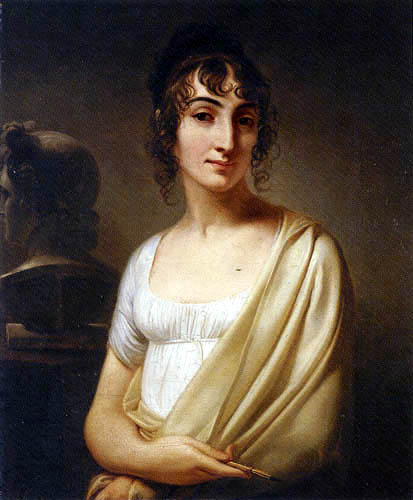
I’ve begun to gallop along on the YA about Hortense. I’m still struggling with the plot, but nonetheless I’ve started falling into scenes, letting them flower. The processes for plotting and writing are different (plotting is so very cerebral), so it’s not a bad idea to do them simultaneously.
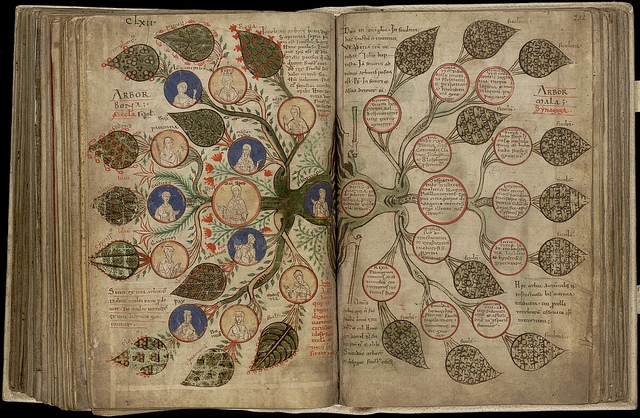
Needless-to-say, I’m busy. There is nothing quite like the absorption of the early stages of a novel to make one just a little forgetful.
Recommended this week: “How to shop at a bookstore: an easy 20-step guide for authors.” This is hahahaouch funny & sad. The one thing I would add is that writers give consideration to appearance before going up the the counter and offering to sign a book. If I’m looking somewhat grubby, I will pass.
The article made me nostalgic. I remembered walking by a bookstore just before I was first published, realizing that I would never again go into a bookstore as a carefree-wandering-reader. Once published, there’s a working relationship. A delicious working relationship, but a working relationship nonetheless.
The copy-edit of The Shadow Queen is now back with Doubleday. I always find it surprising how emotionally tangled up I can get over whether a word is capitalized or not.

Now I’ve the beastly Author Questionnaire to finish filling out. The required AQ is perhaps the best reason to stay with one publisher! On the first page (of many pages): list every edition of every book you’ve ever published in all languages. No. No. No.
The catalogue copy of The Shadow Queen for HarperCollins needed some tweaking. (The title was wrong, for starters.) Here’s what we’ve got now for a “shout line”:
A seductive, gripping novel about the lure and illusion of power, and the plight of a woman caught up in the deadly black magic of the woman she loyally serves: the Shadow Queen.
Shout lines are damn hard … Some suggest that you begin writing the shout line at the same time you begin writing the novel.
As usual, I’m reading too many books at once. (A little ADD anyone?) Pride and Prejudice, as well as a book about Jane Austen—as mentioned in my last blog. Tiny Beautiful Things by tell-it-like-it-is Cheryl Strayed. Astonished, by my friend (and fantastic writer) Beverly Donofrio. A historical novel for a blurb—I don’t recall the title, but I’m enjoying it very much. Manage Your Day-to-Day by Jocelyn K Glei, for obvious reasons.
Etc. etc. etc. If only I had five lives.

And … how could I forget! I’m nearing the end of Henderson the Rain King by Saul Bellows. Primal lion screaming! I read that Joni Mitchell was inspired to write “Both Sides Now” reading this amazing novel. I read it in my teens and loved it. Although I found it a little thick in the middle, it still has incredible power.

At the top, a very unusual portrait of Hortense by Appiani. Antique images from BibliOdessy.
SaveSave
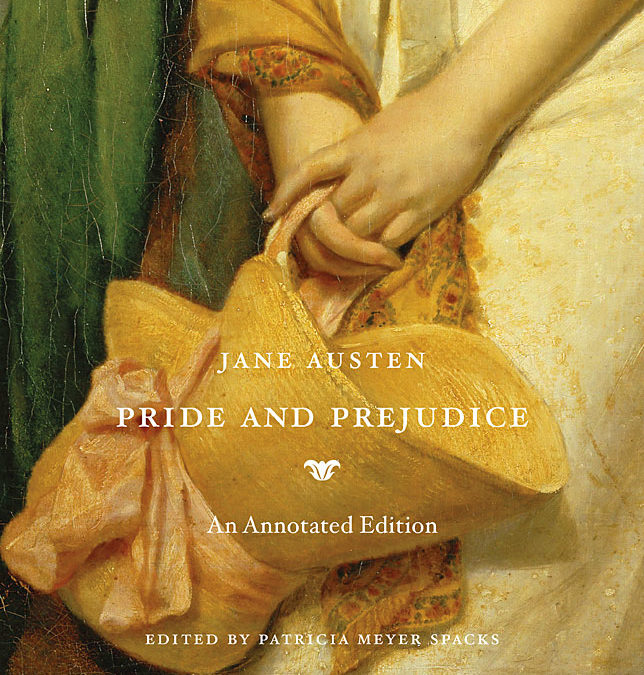
by Sandra Gulland | Jun 6, 2013 | Adventures of a Writing Life, On Research, The Game of Hope, The Writing Process, Young Adult Literature |
As research for writing a YA about Hortense, I’m reading a lot about Jane Austen right now—or, at the least, I seem to be surrounded by books and blogs about her. Yes, I admit, I’m seeking her out.
For example, this wonderful website: What Jane Saw, an exhibit she actually went to see. Follow in her footsteps; look at the paintings she saw.
I’m reading—very, very slowly—the Harvard University Press annotated edition of Pride and Prejudice (shown above). This is a sumptuous book, a sumptuous series. (For a video on this book: click here.)
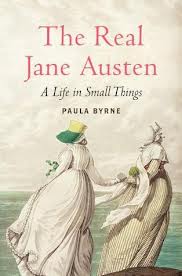
Another book I’m reading is The Real Jane Austen: A Life in Small Things by Paula Byrne: delicious.
And another: A Dance with Jane Austen by Susannah Fullerton, which I discovered through the wonderful blog Jane Austen’s World. This is a wonderful book.

“Why Jane?” my son asks, and I have to tell him frankly that I don’t think she’d be his cup of tea. But then neither might be Dickens or Shakespeare, at least not in his fast-paced world. In a University course: certainly. And then, forced into another time and pace (the beauty of higher education), he might think, “Wow.” For she’s right up there with the greats of literature.
This in spite of the fact that she is so very subtle, so not showy. Who was it who said—I think it was Virginia Woolf—that it’s very hard to catch Jane Austen in an act of greatness.
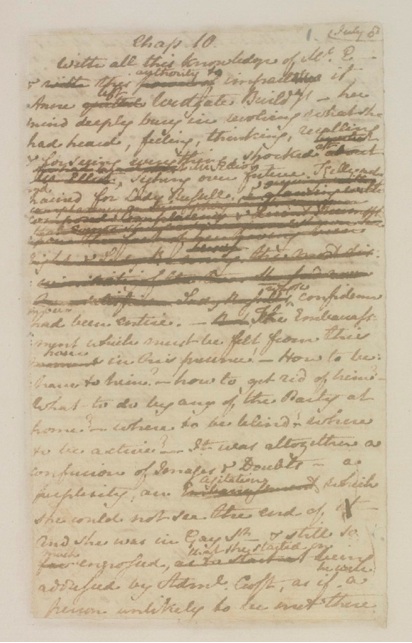
She wrote during the day, and read what she’d written to her family in the evening. She did not have a desk of her own, much less a room.
It’s a mistake to think that her’s was a purer world. The worlds she created are pure, yet a man she and her sister admired, a nobleman, had a strange affection for drinking the blood of his servants. (Note that such details do not show in her novels.)
For Mother’s Day, my son suggested I pick a t-shirt from this wonderful site: Out of Print Clothing.
Which one did I pick? Well, of course: Pride and Prejudice:

I love it! (And no: this is not me.)
What’s your favourite Jane Austen? And why?

by Sandra Gulland | Jan 3, 2013 | Adventures of a Writing Life |
I’m busy diving into the new year (as are you all, no doubt). So quick notes.
I just sent out a special newsletter offering a chance to win one (or more than one!) of these books. It’s not too late to enter: here.
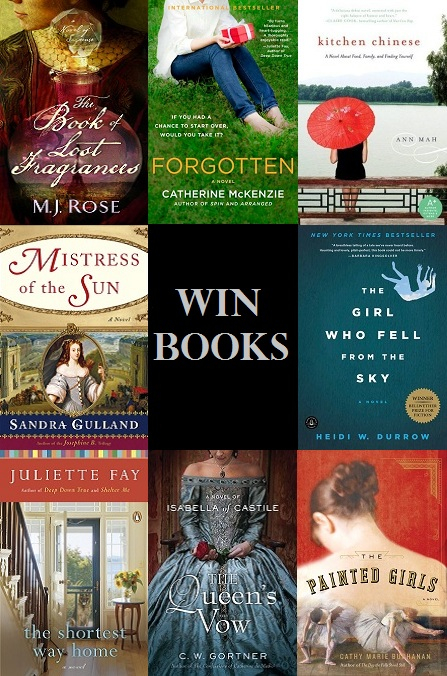
I have two blog mentions you might enjoy. One: what I have to say on Advice to Writers blog. (“Persevere!”)
And another, a charming article by novelist Randy Susan Myers for Beyond the Margins (a great blog): “Writers Wearing Costumes, Baking Cookies & Other Mad Men Tricks.” I bet you can guess which author will be the one wearing a costume.
And last, I love this photo a Twitter friend sent of her Trilogy in the Serbian edition.
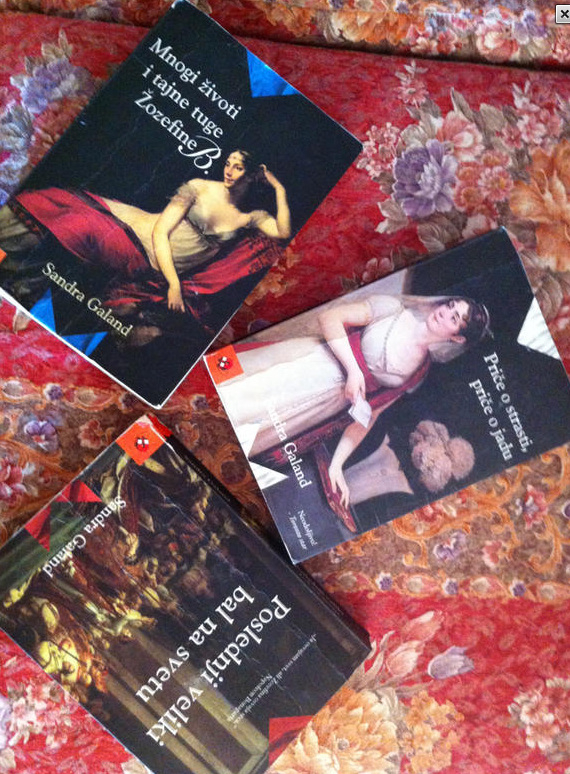
I especially love how well-thumbed the books look: clearly read and reread.
Back to work! I’m delightfully lost in the Land of Research. (See this blog post on my discoveries.)
by Sandra Gulland | Dec 25, 2012 | Baroque Explorations |
We all know the song “The Twelve Days of Christmas”: I thought, for this post, I would have a look into its history. As with any research, one thing leads to another …
The words to the song were first printed in a children’s book, Mirth Without Mischief, in 1780.
(The title is quite delightful as is, but even more so with the addition “…or the Gaping Wide Mouthed Waddling Frog.” You can buy a reproduction copy of Mirth Without Mischief through Amazon: click here.)
In Mirth Without Mischief, “The Twelve Days of Christmas” is presented as a memory game. Players gather in a circle, and each one in turn says the first line. Then, when it comes around to the first player again, he gives the second line, and so on, until someone messes up and punishment ensues.
Of course the song itself dates further back, some even claiming its origin in the 16th century. It is generally thought that the original verse was French. Others claim it was a Catholic catechism memory song, taught to the children of oppressed English Catholics during the Reformation. (This theory is considered to be an urban legend by some.)
The twelve days of Christmas is a custom that originally goes back to the Roman celebration of Saturnalia followed by twelve holidays, ending January 1. Now (usually) the twelve days of Christmas—known as Christmastide and Twelvetide—begin on December 25, Christmas day, and end on January 5. In some cultures, the twelfth day is January 6, the first day of Epiphany.
As with any historical exploration across cultures, dates will differ. For some, Saint Steven’s Day (Boxing Day) marks the beginning of the twelve days of Christmas, with welcome candles put in windows. A Yule Log (an ancient custom handed down from the Druids) was kept burning until the New Year to ensure good luck from year to year.
Twelfth Night marks the traditional end of the Christmas season: but does it fall on January 5th or 6th? That, too, depends. We live in very Catholic Mexico in the winter, and January 6th is the big event here. The night before, while children sleep, fathers swarm into the markets to buy their children a gift to discover in the morning. Even the big department stores stay open, and taxis and buses are busy taking parents from shop to shop in the dark of night.
The Twelfth Night party is celebrated with a King Cake (Rosca de Reyes here, Gateau de Rois in French-speaking countries) in honour of the three Wise Men. It’s a yeast cake filled with dried fruits and nuts. It is based on an ancient Arab recipe, and has been made in this way by Christians throughout most of Europe since the Middle Ages.
In Mexico, as in times past, the person who gets the piece with a plastic baby Jesus in it (a pea or bean in former times, of course) is crowned. Here the tradition is that that person is then obliged to give the Twelfth Night party the following year.
I love this etching of Christmas festivity gone wild:
Rest assured that however you celebrate the holidays, whatever you do has a long and very merry tradition.
Here’s wishing everyone Happy Holidays, and a wonderful New Year! Keep that Yule Log burning.
Links:
Wikipedia on the song “The Twelve Days of Christmas”
Lyrics for “The Twelve Days of Christmas”
by Sandra Gulland | Nov 5, 2012 | Adventures of a Writing Life |
After over four weeks of travel research with only a carry-on suitcase, we’ve landed in our winter home in lovely San Miguel de Allende, Mexico. (I’m leaving my suitcase out: in exactly two weeks we’ll be going to California for U.S. Thanksgiving with my soon-to-be 95-year-old dad and the rest of my family there.)
Today I’ll tackle getting my office set up so that I can Get To Work. It’s urgent! I’ve “the last revision” to make on The Next Novel for my wonderful editor Melissa Danaczko at Doubleday before it goes into copy and line editing. Deadline: early January, but best before if I can manage it, well knowing how little gets done over the holidays.
And also knowing that I have two Young Adult novels about Josephine’s daughter Hortense to get to work on!
We had a wonderful trip to England, France and Switzerland. One of the highlights was going to Arenenberg, Switzerland, to see Hortense’s last home and the Napoleonic museum there.
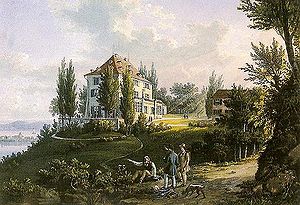
{Arenenberg, Hortense’s last home overlooking beautiful Lake Constance in Switzerland, now a wonderful museum.}
I got an enthusiastic welcome! Everyone had read the Trilogy and loved it. They sell quite a few of the German edition in their gift shop and I signed many, many copies for them.

The museum was astonishing. I got a wonderful tour from Christina Egli, Deputy to Dominik Gügel, the Director. I will have details to report on my research blog, but for now I’ll just leave you with a photo of the lovely statue of Hortense that’s in the chapel there:
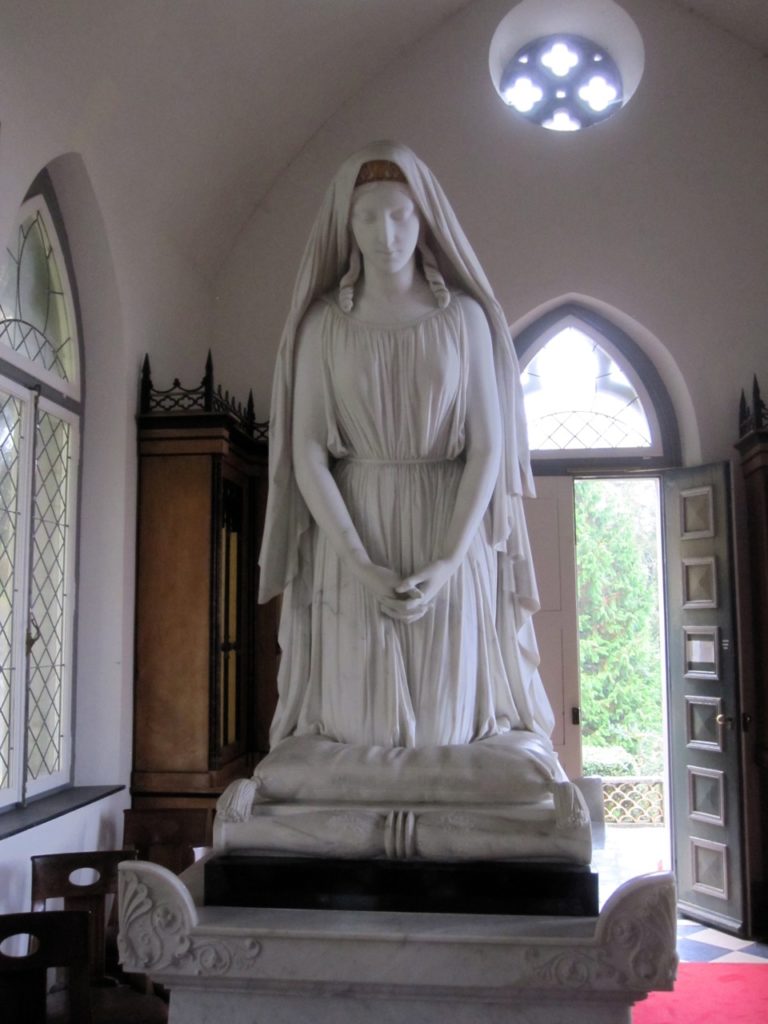
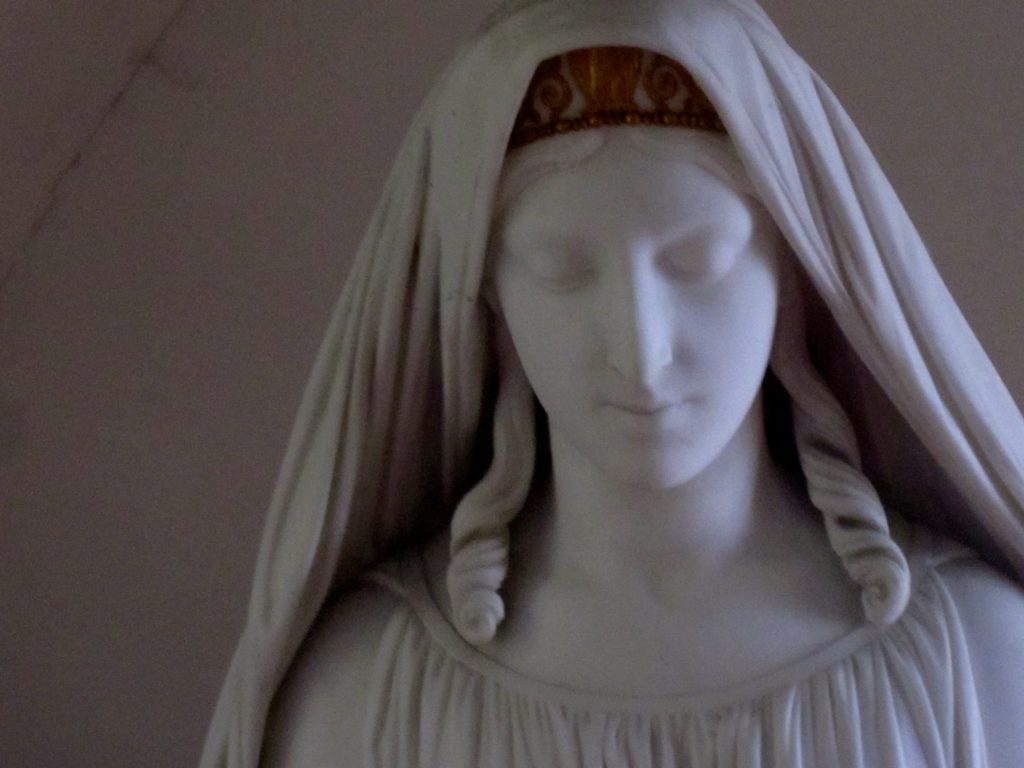
SaveSave




![]()














